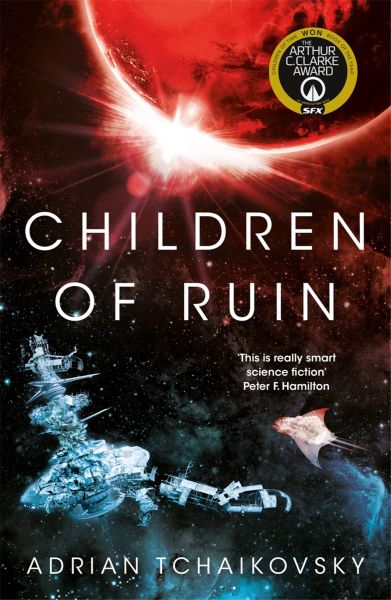Voices in My Head
Children of Ruin (Children of Time, volume 2)
By Adrian Tchaikovsky

30 Jul, 2019
0 comments
2019’s Children of Ruin is the second book in Adrian Tchaikovsky’s Children of Time series.
Before it annihilated itself, Earth’s first great technological civilization dispatched starships to nearby star systems, there to terraform promising worlds. Millennia later, Earth’s second great technological civilization also dispatched starships. The purpose was not to reshape worlds according to humanity’s whim, but to escape the deadly trap Earth had become.
Nobody expected to find a planet full of portiids, genetically engineered intelligent spiders, but humans were convinced… compelled, really, to come to terms with the unintended products of Avrana Kern’s bold uplifting efforts. The starship Voyager is the product of the unexpected partnership, crewed by humans, portiids, and an emulation of the long-dead Kern, dispatched to explore a neighbouring star system. Who knows what wonders await them?
The planet Damascus had its own visionary, Disra Senkovi. Like Kern, Senkovi set in motion a bold uplift program. Kern had focused on primates (the spiders were entirely unintended beneficiaries of her genius). Senkovi preferred octopi. Like Kern, Senkovi created a new species just as intelligent as humans. There was, however, one major difference between Damascus’ home system and Kern’s World’s home system. It is one that has shaped history.
Voyager finds itself in a system seemingly at war.
Damascus was not the original goal of Senkovi and his companions. It’s an unpromising ice-locked world. The goal was Damascus’ neighbour world, Nod. To everyone’s surprise, Nod had native life, the first non-terrestrial life ever encountered in humanity’s explorations. Life not only able to adapt to Nod but to the exciting new niches offered by the unfortunate terrestrials who encountered it.
~oOo~
The crew of Voyager spend the years between stars in cold sleep. From their POV, it’s only a hop, skip, and jump between planets. For the planetbound it can be thousands of years, years that the author must describe in broad strokes.
Even then, the author has to resort to what I might call insta-terraforming to make the plot work. The current scientific consensus (as represented by Fogg’s Terraforming: Engineering Planetary Environments) tells us that it takes geological time (as in millions of years) to turn hellworlds into garden worlds. The plot requires fast terraforming, so Tchaikovsky imagines abiotic worlds that can be transformed over the course of an extended lifespan. Well, I suppose every SF author gets at least one scientific whopper to jog the plot into motion.
This volume of the series ups the stakes considerably, confronting the Voyager with not one but two new intelligent species.
The octopuses are bad enough. Their neurological arrangement ensures that they are anarchic even on an individual level (a mini-brain in each tentacle). They are flighty and mercurial. Their society is composed of fluid alliances that can abruptly collapse and reshape. Dealing with octopuses is difficult.
But the Nod entity … well, that’s a horror straight out of Who Goes There, consuming and protean, with a vexing ability to sidestep terrestrial immune systems. From a human, portiid, and octopus perspective, “nuke it from orbit. It’s the only way to be sure!” seems quite reasonable.
That’s not where Tchaikovsky takes his story, however. The running theme in the Children series is the search for peaceful coexistence despite seemingly unbridgeable divides. This volume is no exception. It’s a welcome change from SF’s love for genocide as a cure-all.
Children of Ruin is available here (Amazon), here (Amazon.ca), and here (Chapters-Indigo).
